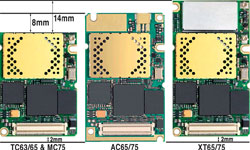

Today’s GSM product that requires only voice or GPRS functionality may well need EDGE or GPS technology tomorrow.
To support such a rapidly changing market effectively, engineers need a GSM solution that is as flexible as their products need to be. With the scalable wireless module platform from Siemens, upgrading a product to support EDGE or GPS need not require a hardware re-design. The modules share a common connector and pin assignment across the family, enabling designers to develop products that are scalable. In this way, developers can have several products with different features, all built from the same PCB design. Upgrading a product that supports only GPRS to support EDGE and GPS is claimed to be as simple as populating a different module on the application board.
With dimensions of 34 x 45 x 3,5 mm and a weight of less than 10 grams, the compact size of the standard modem products ensures that they will fit into the tightest of spaces. The rugged and tracking modules offer additional functionality and as a result are slightly longer but their connector, mounting-hole position and width remain the same.
These quad-band modules include an integrated TCP/IP stack enabling the integration of wireless Internet services as well as an RIL driver, which makes them particularly attractive for Microsoft Windows Mobile-based devices. Standard interfaces such as serial ports, USB port and an I C bus are said to make it easy to connect the modules to any M2M application. The USB port allows plug-and-play functionality, which is particularly convenient when developing GSM/GPRS/EDGE modems. The modules also support SIM Access Profile making them well suited to hands-free mobile phone applications. With these enhanced features and technology support, these wireless modules suit applications such as tracking, fleet management, GSM modems, security, vending machines, barcode scanners and POS terminals, to name but a few.
The range of modules based on this platform includes the following:
TC63/TC65 GSM/GPRS modules
With features like GPRS Class 12, quad-band technology and an integrated TCP/IP stack, the TC63 is able to facilitate top-class GSM/GPRS communication for voice and data applications.
In addition to this functionality, the TC65 features a fully-fledged Java-based software developer's platform. Apart from saving development time, this reduces costs, as the module requires no additional hardware such as a controller or memory. The Java Virtual Machine is supported by an ARM7 processor, with 1,7 MB Flash memory for the application software as well as for data. Owing to its IMP 2.0 profile, the TC65 allows users to make application software updates easily and securely to units in the field via the air interface (OTAP). In addition to this, it enables data encoding in applications that involve transmitting data in a secure environment (eg, HTTPS and PKI). Integration into an M2M application is facilitated by the inclusion of an SPI bus, general purpose digital I/Os and analog I/Os in addition to the interfaces available on the TC63.
MC75 EDGE module
As GSM evolves in the direction of UMTS, the EDGE standard's role is growing increasingly important. While the UMTS infrastructure is still being developed, EDGE already ensures global coverage even in rural areas, allowing it to fill regional gaps during the transition period until UMTS is launched. The MC75 supports EDGE Class 12 with a maximum data transmission rate of 236,8 Kbps in addition to the features available in the TC63.
AC65/AC75 rugged modules
The Java-based AC65 (GPRS/GSM) and AC75 (EDGE/GPRS/GSM) modules are designed to work reliably in harsh environments and at extreme temperatures. The modules, developed in accordance with the ISO/TS16949 technical specification for automotive products, meet quality standards such as VDA 1.5 for audio quality transmission. They are provided with additional mounting holes and a robust SMP antenna connector, and operate at temperatures up to +85°C.
A number of intelligent features minimises the risk of failure while the modules are in operation. Automatic antenna diagnostics constantly indicate the aerial's functionality and the current connection status to the application. Impending problems can thus be detected and remedied quickly. The application is also able to read the current temperature of the board by means of an AT command. If the temperature reaches a critical value, then applications are able to take action in accordance with the designer's temperature strategy.
XT65/XT75 tracking modules
The XT65 and XT75 combine GSM and GPS technologies operating simultaneously on a single board. These modules are designed for all applications which have to provide a service centre with the location of an object, vehicle or person, eg, personal tracking devices, vehicle recovery systems, and fleet management devices. Both modules include Java and the XT65 supports GPRS while the XT75 features EDGE technology for high speed data transmission.
Their quad-band GSM technology enables the application they are fitted into to transmit data from anywhere in the world and the GPS receiver allows tracking with a sensitivity of -158 dBm. In addition, the XT65/75 supports assisted GPS (A-GPS). Thus, with the use of an Assistance Server a location can be obtained in the harshest of environments and the time taken to obtain a 'first-fix' after switching the GPS receiver on is reduced dramatically.
In addition to the above product features, Siemens has a local support team dedicated to assisting developers with product evaluations and ensuring they get the most out of the technology. The company also provides the type approvals necessary for worldwide use, free of charge on all its wireless modules. Thus, they meet requirements in accordance with R&TTE, FCC, IC, UL, GCF, and PTCRB as well as any country-specific requirements which network providers may have.
For more information contact Karlo Glorioso, Siemens, +27 (0)11 652 2000.

© Technews Publishing (Pty) Ltd | All Rights Reserved